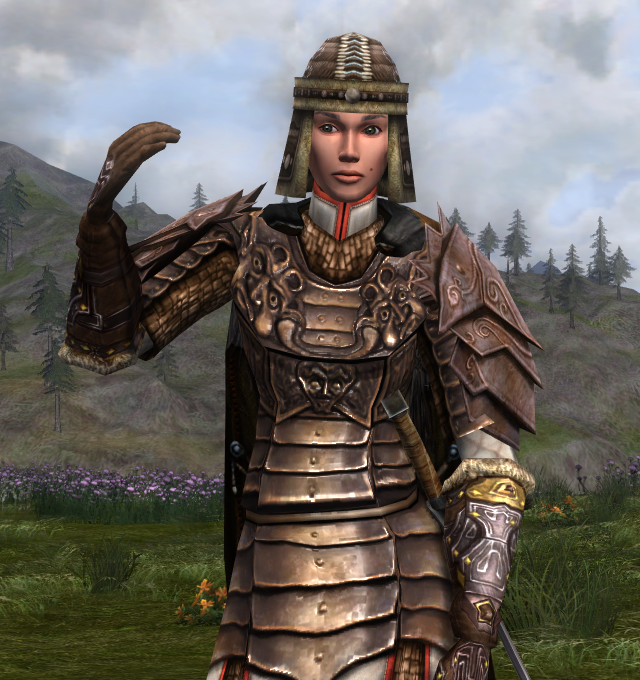
In the wide and little-known lands of the East, beyond even the distant Sea of Rhûn, there lived a people whom the Men of Gondor called the Wainriders. Their own name for themselves is unknown, and it is likely that they were not one unified people, but rather a confederation of various nations and tribes. They were given the name Wainriders by Gondor in the earlier years of the Third Age, when they united their forces to attack Gondor and her allies. Eager for conquest and booty, they had been led into hatred for the Men of the West by the deceits of Sauron, and fell under the Shadow of Mordor. They drove wains, or chariots, into battle and managed to subjugate Gondor’s ally Rhovanion before being defeated by Gondor. Some years later, the Wainriders allied themselves with their occasional foes, the Men of Khand, and with men of Harad and again they assailed Gondor. Again they were repelled, and retreated to their eastern lands. The Wainriders did not attack Gondor again, but some of their descendants likely numbered among the Easterlings that fought for Sauron in the Battle of the Pelennor Fields at the end of the Third Age. Little else is known of the culture of the Wainriders, but it is said that their “younger women were gained in arms and fought fiercely in defense of their homes and children”.
![]()
This woman is an unwed maiden of a people descended from the Wainriders of old. She dwells in the wide lands to the northeast of the Sea of Rhûn, and like many of the maidens of her people, she is able to track, ride, shoot, hurl javelins, and wield a sword. When eventually she is taken to wife she will lay aside these pursuits, but for now her prowess serves her well in hunting and when the semi-nomadic dwellings of her people are attacked by neighbouring tribes. She is seen here dressed for battle, in a finely-quilted hauberk reinforced with armour of overlapping brazen bands decorated with carefully beaten, leering faces to intimidate her foes. A warm felt cap protects her head from the elements and her cloak bears the pelt of a wolf that she herself hunted and slew. She is fierce and ready to fight and indeed she may have to, should her village fall under attack by raiders, for many of the men-folk of her people have marched far away to war under the banner of the Eye of Mordor.

As I mentioned in a recent post, I’m really intrigued by the cultures of the Easterlings and Southrons. Details on them are sparse and tantalising, but it may be possible to make some deductions and fill in some blanks when trying to depict their culture. Now here comes the armchair anthropology! Some of the descriptions of various Easterling peoples remind me of ancient Primary World cultures from the western Eurasian Steppe. In particular, the description of the battle-prowess of some Easterling women reminds me of the Sarmatians, who buried many of their women with armour and weapons, and who may have been the origin of the legends of the Amazons. I’ve titled this outfit with “amazon” in the sense of “warrior-woman”, not the mythical race of women. Like our Easterling amazon, the Sarmatians were Caucasoid in appearance, being fair of hair and complexion (and allegedly “fierce of eye”). The uprising of the Woodmen of Rhovanion against the occupying Easterlings in IIIA 1899 is somewhat reminiscent of the attacks by the Goths against the Sarmatians in the Primary World’s fourth century (I have previously commented on the Gothic-style names of the Woodmen, such as Marhwini). Finally, there is the vehicle which gives the Wainriders their name, the chariot, the use of which was of course pioneered by the peoples of the Eurasian Steppe in the Primary World. The word “wain” has come to be a mostly literary term meaning waggon or cart, but it is also an archaic term for chariot that can have a pagan or heathen connotation which the Men of Gondor would likely have ascribed to the Wainriders themselves since they were considered Men of Darkness. The Hauberk of Rhûn, as its name suggests, made a good start for an outfit for an Easterling warrior-woman. Its armoured portion is appropriately eastern-influenced, being laminar or “banded” armour (not to be confused with lamellar or “splinted” armour). Laminar armour was used in the Primary World from Iran to Mongolia, and so seemed a great choice for an Easterling from the lands near the Sea of Rhûn. The shoulders that I used take on dye in an unusual way, and when dyed orange (of all things!) they blend almost perfectly with the collar of the hauberk’s armoured portion.
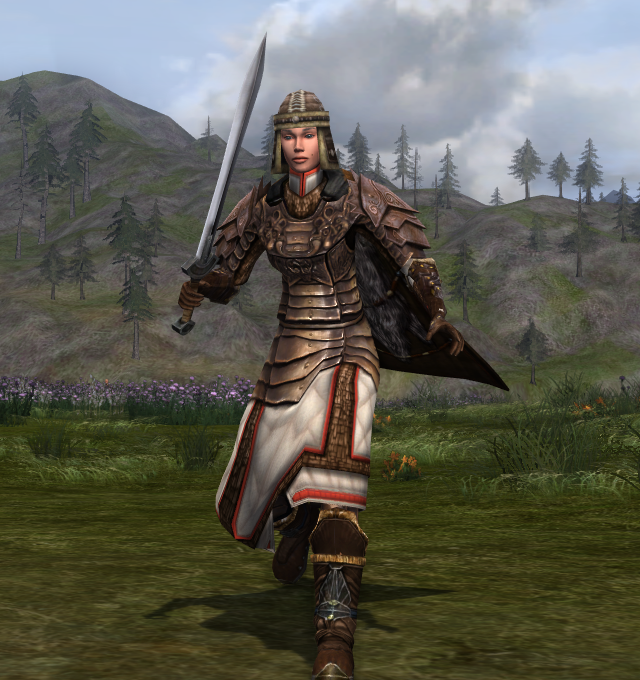
- Head: Ceremonial Ajokoira Hat (crafted — tailor T5/Lossoth reputation), umber
- Shoulders: Elven Warrior’s Shoulder Guards (crafted — metalsmith T5; or looted — world drop/general), orange
- Back: Cloak of the Algraig (purchased — LOTRO Store), default
- Chest: Hauberk of Rhûn (purchased — LOTRO Store), sienna
- Hands: Stone-guard’s Gauntlets (bartered — Echad Andestel Guardian trader or Caras Galadhon Guardian trainer or Ost Galadh Guardian trainer), umber
- Feet: Ceremonial Pathfinder’s Boots (bartered — skirmish camp cosmetics quartermaster/Moria cosmetic clothing – medium), umber
Tips: The Stone-guard’s Gauntlets can be bartered cross-class using Medallions of Lothlórien in Echad Andestel. They have the same appearance as the Gauntlets of Durin’s Guard (bartered — Twenty-first Hall Guardian trainer). The boots used in this outfit have the same appearance as those from the other level 58 Mines of Moria instance cluster medium armour sets.




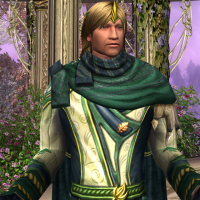

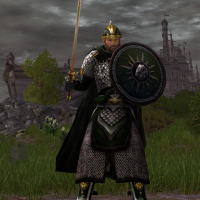
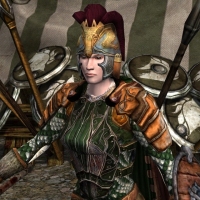
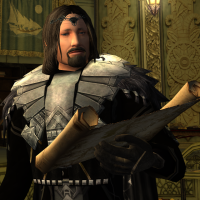


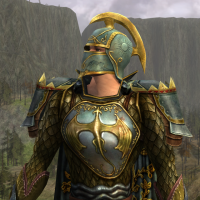

I’m a big fan of the boots from this outfit, I like the silver triangle on the front. 🙂
I love those boots too, they’re great! I chose them for the gold-ish fur trim to match the same on the gloves and tie into the hat trim a little too. Plus in the back view shot you can see there is a little blueish-grey band on the boots that matches the triangle at the upper part of the cloak. 🙂
yep
A simple enough outfit, and I can’t say I like the purplish highlights on the hands, but it serves. I’m more interested in the Real World historic parallel: equating the Rhovanion revolt with the Gothic/Sarmatian conflict is an impressive inference, though if not for the obviously Gothic slant of the Woodmen I would be more inclined to point out the Limigantes rebellion instead (I hold that they were Dacians). But then the Völkerwanderung is not precisely my cup of tea, so I defer to you.
And so we are another step beyond Anduin. I commend you.
I hadn’t heard of the Limigantes and had to look them up: very interesting!
I once read a paper that was drawing a series of Primary World cultural parallels for the early Third Age in which Gondor was a Byzantine analogue. It was a really interesting paper that I think you’d appreciate, C.T. I’ll see if I can find a link to share.
… Found the paper. It is “‘Byzantium, New Rome!’: Goths, Langobards, and Byzantium in The Lord of the Rings” by Miryam Librán-Moreno in a collection of critical essays re: Tolkien source criticism. Here’s the Google Boook. The whole collection looks really interesting, I think I will have to pick it up to give the paper a proper read!
Oooh, awesome, new reading material! Starry, as always, I love your anthropological take on things. And eee, love that hauberk.
Thanks so much Laelis! Like I’ve said, it’s always reassuring to hear this kind of thing is appreciated. I’m always worried it’s a bit beyond the scope of a cosmetics blog. 😀
To my local lending libraries: y u no stock this book?
Thanks for the tip Starry, I’ll keep on keeping a look out for this particular title. I can see Gondor being compared to Byzantium (Númenor then being Rome?), it has a better ring to me than Tolkien’s own likening of it to Egypt (well, at least the view of Egypt as a colony of Atlantis).
Not surprised to see an entry on the Rohirrim/Anglo-Saxons parallel; I always did like the theory that Rohan represents Tolkien’s wistful dream of an Anglo-Saxon “rider culture” that survived the Conquest.
The Hauberk with the Elven Shoulders is a great combination. I also think the cloak is a great match. Though the hat is probably a good match to the style, I think it looks just a bit too silly on a woman. I don’t know what it is with hats in Lotro, but most of them make me cringe. Frankly I think the heavy Lossoth helmet or even the medium one would have been a better match here and make it even more “Easterling”-ish as the face would be covered. Other than my personal issue with hats, it’s a really good Rhûn outfit.
Thanks Hymne! I know what you’re saying about the silly hats (LOTRO hats: it’s complicated). It does seem like hat are cosmetics going in a different direction recently, away from the “bucket hats” look of early days, so hopefully that trend will continue with lots and lots of new and varied hats!
Especially in the earlier levels, like levels 5-15. The start getting better from there though.
😉
It’s been a while since I’ve commented, so I thought I’d come and say hi. 🙂 Once again, I love this new outfit: the combination of the hauberk, cloak and shoulders is great (I’ve always liked each piece seperately, but never thought of combining them). The boots are also very nice – I notice that often I miss beautiful details in outfit pieces when glancing over them in-game, but discover their beauty later in blogs like yours. 🙂 Also, thank you for all the wonderful lore and history information! It’s always interesting to learn more about the world we play in and about how Tolkien might’ve drawn inspiration from the primary world.
Keep up the good work!
Hi Mephet, it’s good to hear from you! 😀
Thanks so much for the kind words, really glad you enjoyed the outfit and my lore musings/ramblings!
Hmmm.. that paper looks really interesting. I followed the link and took a look-see.. I might try and pick that up for a little light reading. Haha. 😉
I always like seeing new interpretations of that hauberk and like what you did with it. All those details are amazing.
Aaand, on the contrary.. I love anthropology and truly appreciate how you compare and contrast cultures in Middle Earth to the real world. It provides a nice flavor to the cosmetics, attaches greater meaning and lends an academic feel to your blog. I think the scope works really well.
–Ivy
Thank you so much Ivy, I truly appreciate it. 🙂
And yes, that book looks excellent. It’s got some big-name contributors too, like Shippey and Rateliff (too bad there’s no Flieger, but I just picked up “Green Suns and Faërie”). Anyway, I’m really looking forward to diving into the source criticism book!
Love the Easterling look. 🙂 I RP an Easterling as my main, Faewyrn on Landroval.
Thank you Faewyrn, and welcome! It’s great to hear approval from someone who RPs an Easterling character! 😀